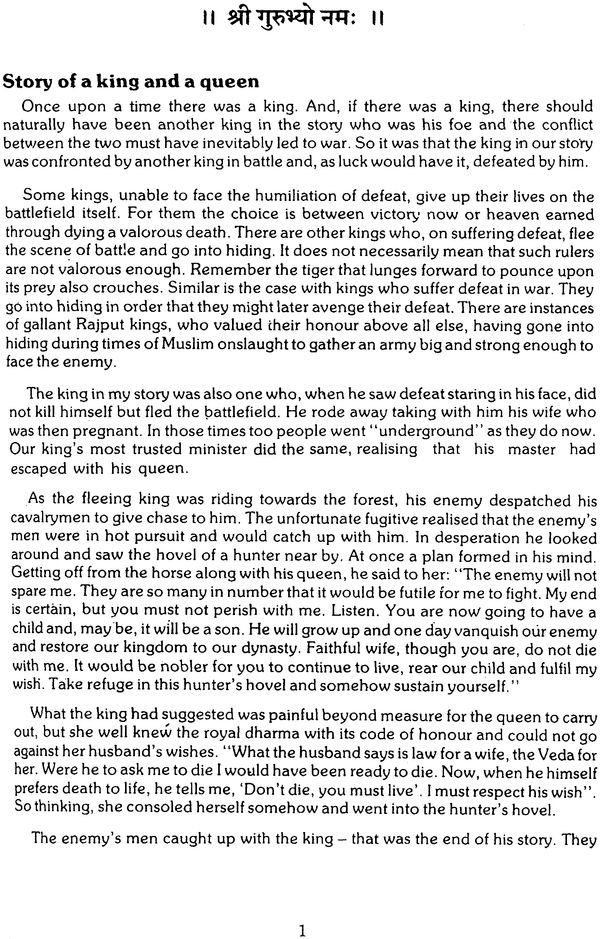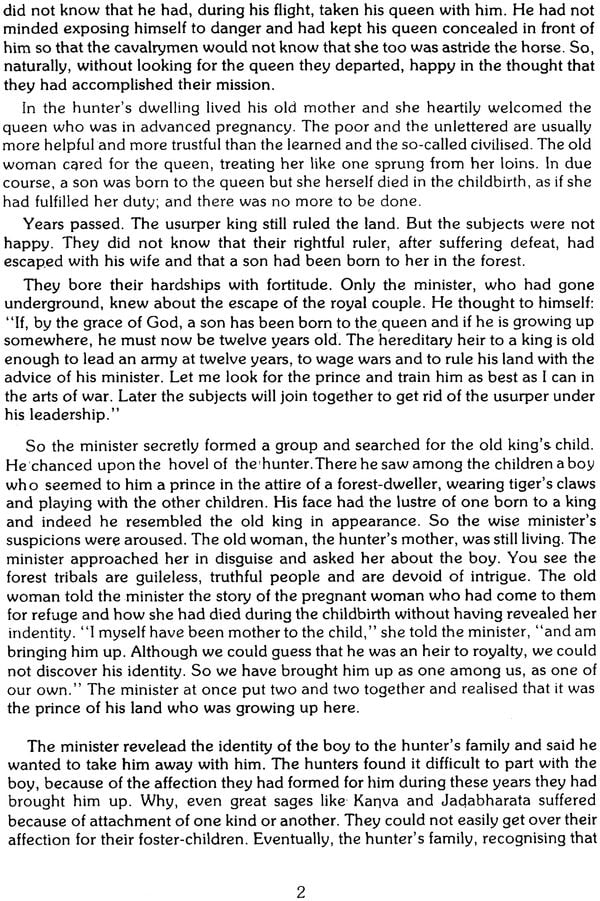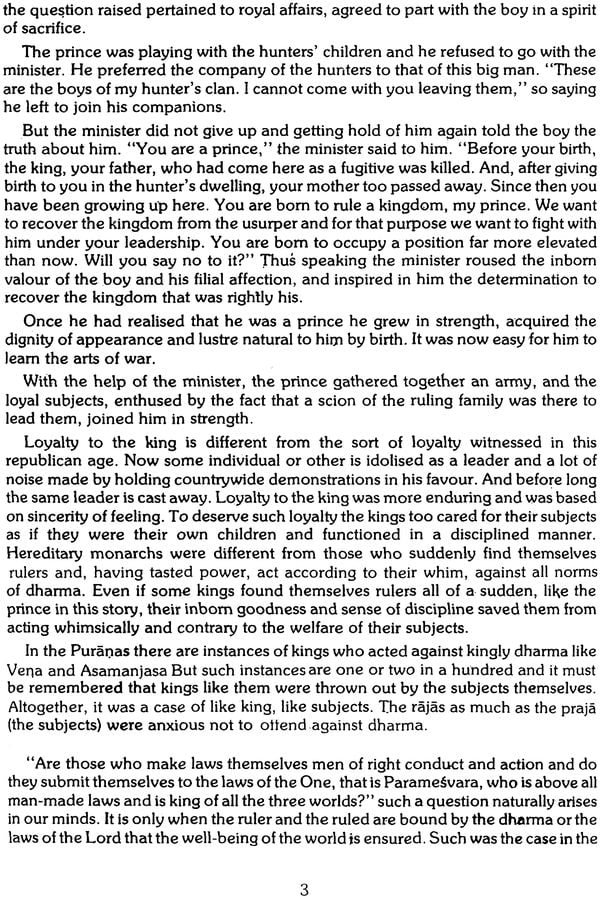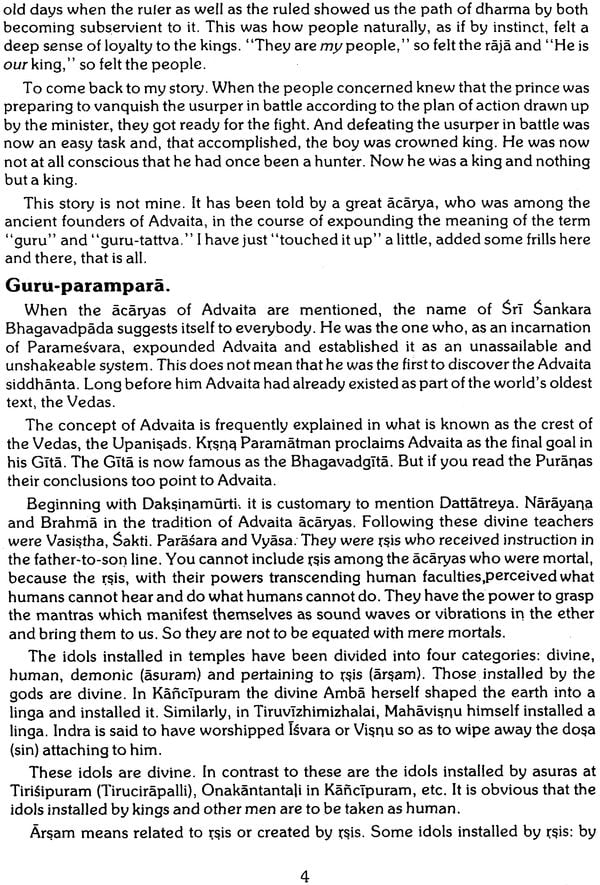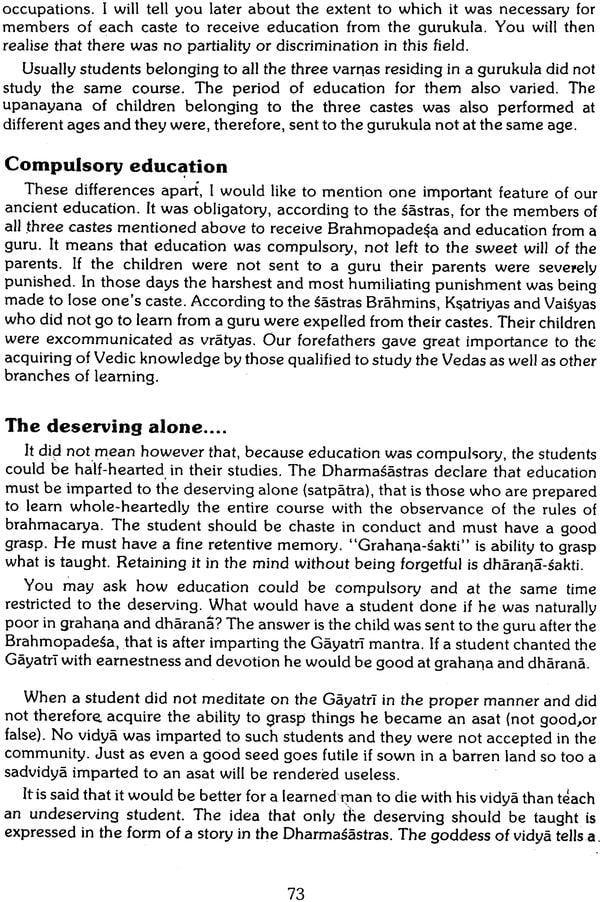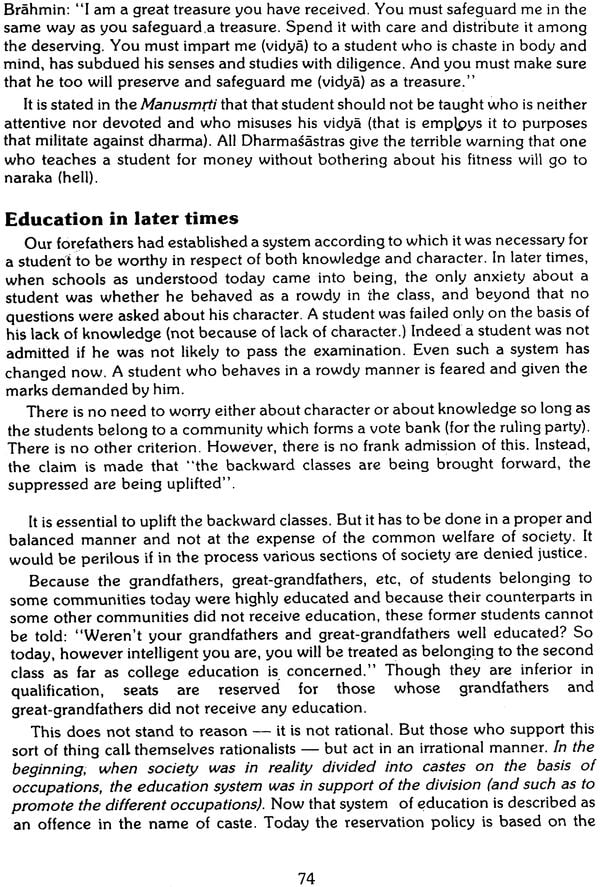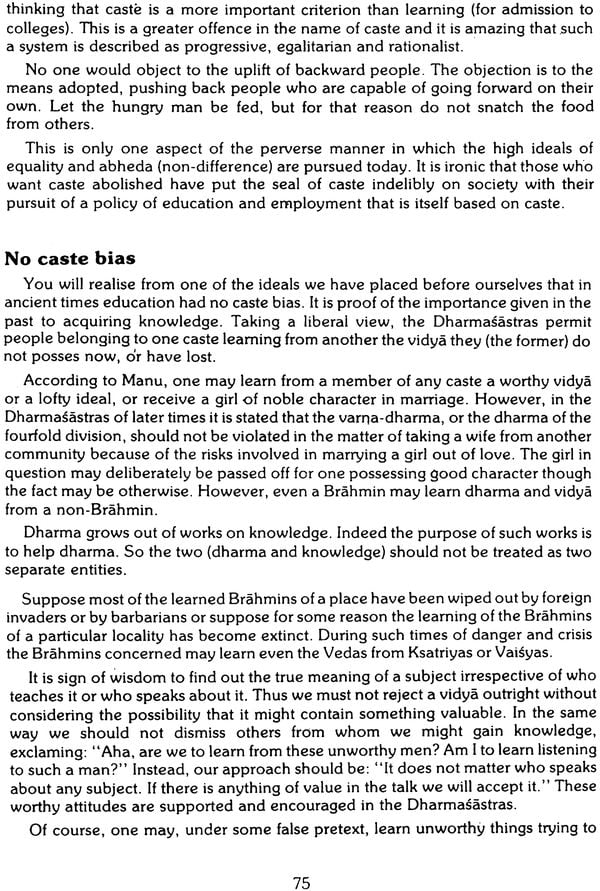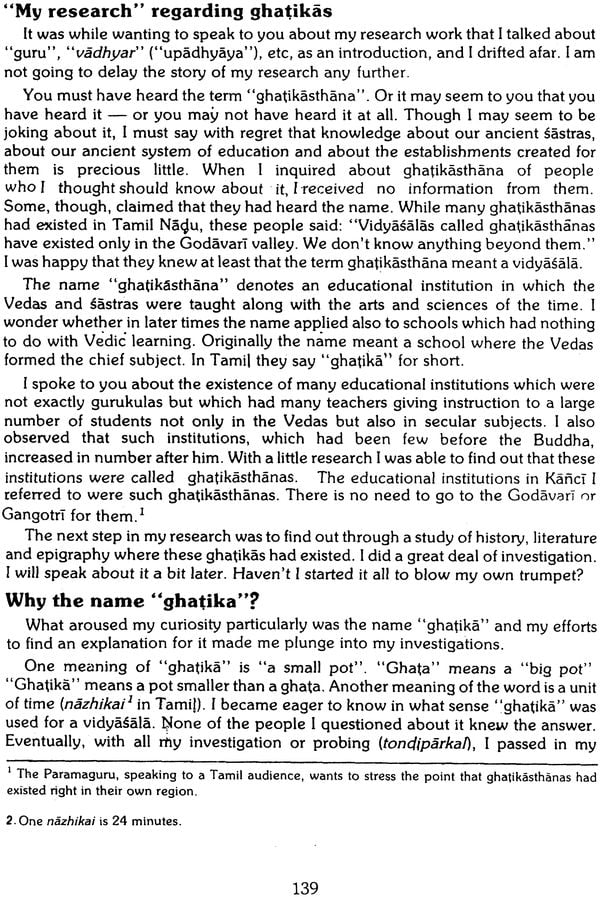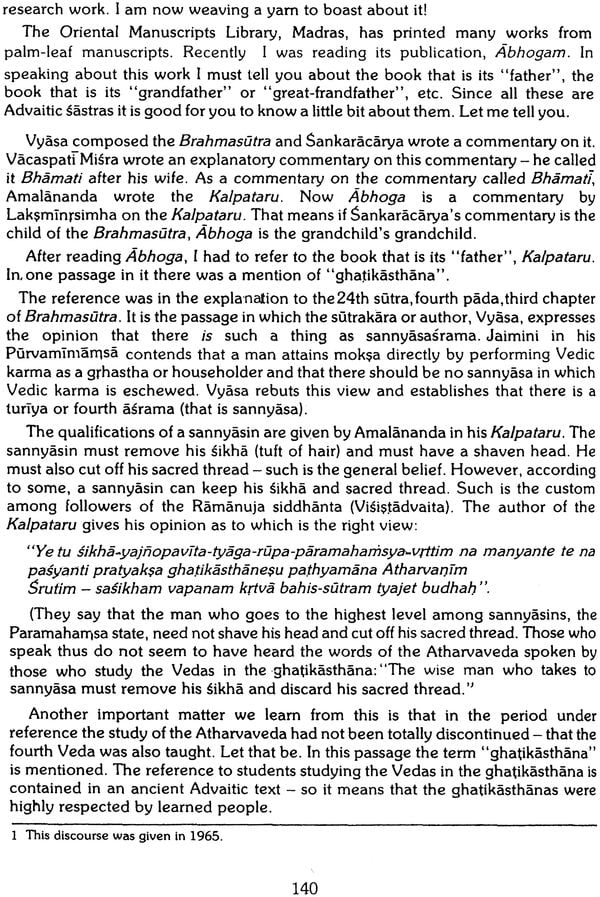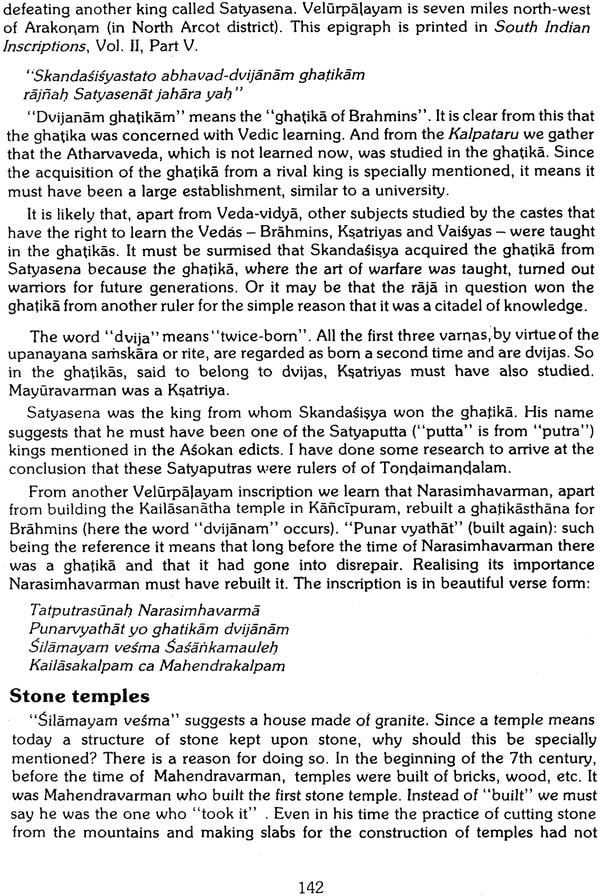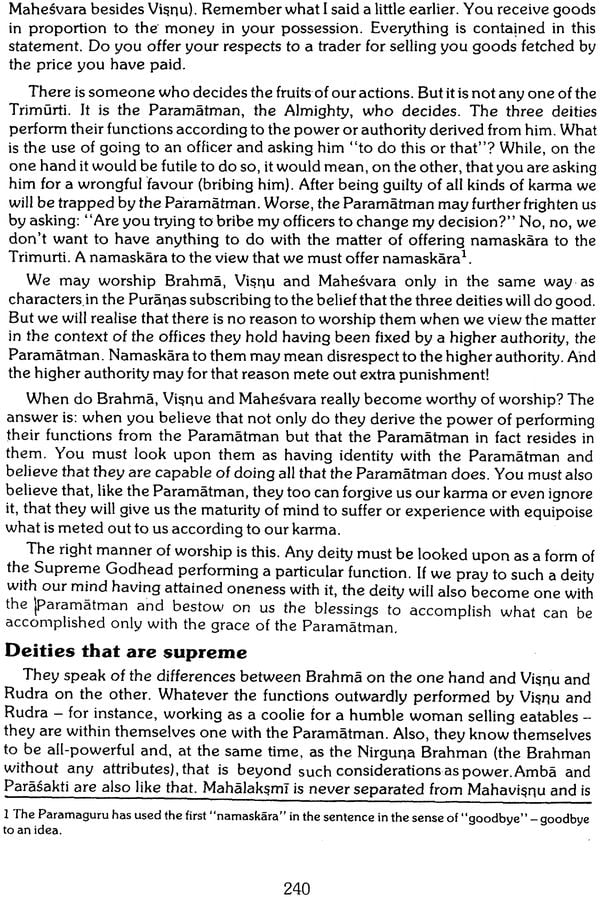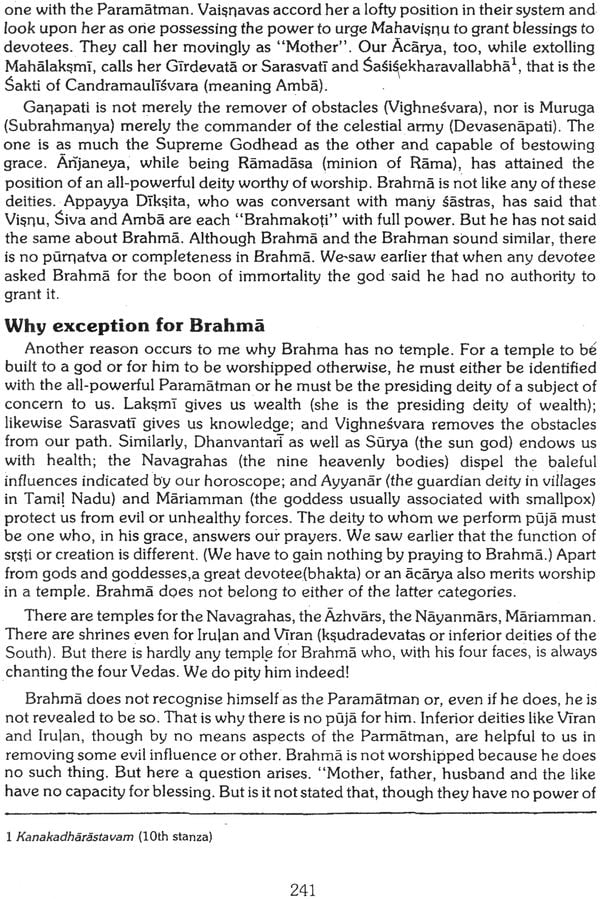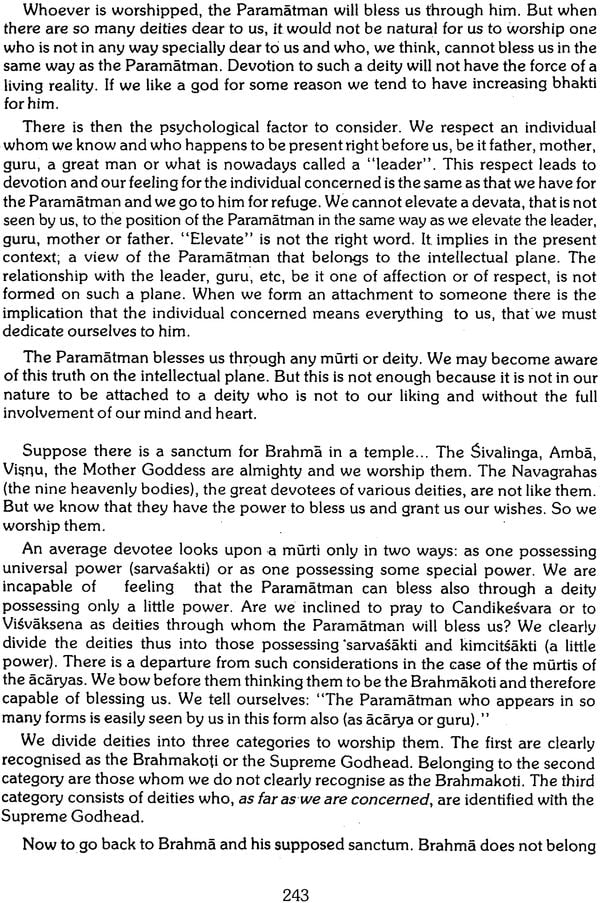
The Guru Tradition (Voice of the Guru Jagadguru Sri Chandrasesharendra Sarasvati Svami)
Book Specification
| Item Code: | IDK729 |
| Author: | Adiguru Dakshinamurti |
| Publisher: | Bharatiya Vidya Bhavan |
| Edition: | 2008 |
| ISBN: | 9788172764159 |
| Pages: | 279 (2 Color Illustrations) |
| Cover: | Hardcover |
| Other Details | 9.6" X 6.6" |
| Weight | 710 gm |
Book Description
Pujyasri Chandrasekharendra Sarasvati Svami of the Kanchi Kamakoti Pitha is one most attractive and inspiring figures of our time. Millions if people regard him as a divine presence and look to him for grace. He is the authentic voice of Hinduism, the authentic voice of india, and yet he is a universal guru. In the midst of all our conflicts all our difference and all our petty rivalries, he stands as a gopuram a reminder of all those ideals and values that are etemal.
In his frall person this Great Acharya encompasses an ocean of knowledge. He was installed the Sankaracharya of the Kamakoti Pitha in 1907 when he was not yet 13 years old. It was the moment when the playful child was transformed into a young master. Thereafter for eight decades his has been a long Yatra to awaken the people of India, to bring about a regeneration in his land.
This Svamiji is a master of the philosophical systems of India with a profound understanding of the cultural systems that constitute the Indian heritage. He is a guru of encyclopaedic knowledge. One who reminds us of the polymaths of ancient times. Yes, he was a luminous mind that takes in everything. But what makes him a great teacher is his insight his intuitive grasp of things and his capacity to illumine. There is no aspect of Indian life or thought on which he has not shed light.
There are few godly people so human as this Great Acharya. His abhaya-hasta brings solace to millions of people and his katasha or sidelong glance can be a profound experience. It brings us an awareness of the unity of existence and for a moment we are bathed in the Great Light.
The concept of the guru is central to Hinduism and is at the heart of the continuity of our civilisation, the guru has a greater place in our history then the ruler or the conqueror. The voice of the guru, of the acharya is heard above the din of all the battles fought on our sacred soil. Do not we still hear the voice of Sri Krishna Paramatman, who played many roles during his divine incamation, the foremost of them being that of Jagadguru?
The guru or acharya more to Indian than the teacher of professor to Europe and other parts of the world. Gurukulavasa, with its tradition of selfless preceptors, is unique to this country and is one of its glories. Without any expectation of maternal gain the gurus in the past worked for the uplift of their studies and the spread of knowledge.
Pujyasri Chandrasekharendra Sarasvati Svami, in these discourses dwells with special emphasis on gurukulas under individual acharyas not supported by any institution. With penetrating insight and with the he surveys the entire educational landscape of India through the ages not forgetting the Buddhist hand Jaina contribution to institutional education.
The sage of Kanchi reminds us that the height achieved by us in past in vidya was due to the fact that teaching was not a "business" and was not institutionalized. He speaks eloquently of the true function of a guru, that of making his student know himself ad freeing him from bondage. "There is no one higher than the guru," he says. "If we truly believe that Isvara himself comes to us in the form of our Guru there is no need for us to worship Isvara apart from our guru. It is faith based on such belief, such devotion to the guru, that will deliver us from worldly existence. "And the grace of Isvara is expressed through the grace of the guru.
As one who shows his sishya the path of deliverance the guru combines in himself the roles of these gods-Brahma, Vishnu and Mahesvara. He is indeed the Parabrahman. In these illuminating discourses the Great Acharya if Kanchi gives us the ultimate upadesa of the identity of guru and Isvara.
Guru according to Hindu way of thinking is an incarnation of god in human from for the Shishya God is universal; the Guru us personal in relationship. Education in he true sense enlightens the person undergoing the process. The inner eye does not open and learning does not get transformed into knowledge until the blessings of the Guru are showered.
Shri Jagadguru Chandrasekhrendra Saraswati is accepted by his devotees as a living God. People close to him adore him as a Jiwan-Mukta. The fortunate ones among the people have his darshan. Those who have the privilege of living around Him are blessed.
The Jagadguru has been living all through his life for the benefit of mankind. He takes the load off from everyone who goes with his woes to him.
"Voice of the Guru contains the blissful advice of the great Jagadguru for the people of the world. Liberal and benevolent the Master does not discriminate between religion and religion, himself the greatest to give a taste of good living to mankind.
These parables are very apposite thought provoking and impressive. The message goes direct to the heart and achieves the purpose.
When made available to the reader in the printed from voice the Guru is bound to provide outstanding reading material of loftier quality and enduring value.
This volume of the Voice of the Guru is an excellent translation of the lectures on Guru-tattva-the concept of the Educator- Delivered in Tamil by Pujyasri Chandrasekharendra Sarasvati Svami, acharya of the Kanchi Kamakoti Pitha, popularly known as "Periyaval", during the long sojourn of the Acharya in the metropolitan city of Madras and its suburbs between October 1957 and about the end of the year 1959. The translation into English has been done by R.G.K. formerly assistant editor of the Illustrated Weekly of India.
I feel that I am quite unsuited to the noble task of writing an introduction to this work. It is only the devotion to the sacred feet of the Great Guru of Kanchi implanted in my heart in my boyhood days and nurtured during the past six decades and more combined with the persistent desire of the translator (an esteemed friends), that has emboldened me to pen this short apology for an introduction.
It may not be out of place to state here that my ears have been fortunate to hear some of the discourses that are found translated in this book. it has been a still greater good fortune for me to have listened to the Great Acharya's remarkable lectures on a variety of subjects delivered at the Sanskrit collage, mylapore Madras, during the last three months of 1932. These lectures to with rapt attention and in utter silence by a vast concourse of people comprising leading jurists, erudite scholars, officials and students, not to speak of ordinary men had the opportunity to hear them and are still alive.
The translation of the speeches on the Guru-tattva printed in this volume is elegant. It is so simple as can easily understood. The Gurdeva's discourses on the concept of the Guru covered in this work encompasses the entire ambit of preceptors and teachers from the sage gurus, the preceptors of gurukulas of the distant past and adhyapakas of pathasalas down to the collage professors and schoolteachers of the present time. The patient reader will not fail to note the wide gulf separating the value-based, devoted disciplined and systematic study that prevailed in olden times- with the consequent attainment by the student of good and perfect knowledge for its own sake -and the educational set-up of today which is devoid of any affectionate or intimate contact between teacher and taught and which has for its aim the securing of degrees deservedly or otherwise as passports to mere material prosperity with the resulting decay in human values and the rise of problem like indiscipline in our educational institutions.
The Acharya's radiant face further up with a smile whenever he made a humorous remark. These occasions find mention in this work. While speaking of the Paramaguru's simile, I am reminded of the observations of Arthur Koestler author of Darkness at Noon and other works, who had an interview with our Great Acharya in Madras on January 10 1959. Mr Koestler writes, " a smile transformed his face into of a child. I had never seen a comparable smile or expression; it had an extraordinary charm and sweetness. Later, on my way back, I wondered why in western painting of saints entranced blessed or martyred, I has never encountered anything like that enchanted smile, "And it is to be noted that the above three sentences are the words of a foreign scholar who spent only about a couple of hours with the sages of Kanchi.
Translating matter spoken or written in one language into another is a hard task. R.G.K. must be congratulant on his having translated the Acharya's discourses into English for the benefit of those who cannot read them in the original Tamil. It is my humble request to teachers and students of collages as well as scholars to get a copy of this valuable work and reap the rich benefit of going through it.
Translating Matter spoken or written in one language into another is a hard task into English for the benefit of those who cannot read them in the original Tamil it is my humble request to teachers and students of collages as well as schools to get a copy of this valuable work and reap the rich benefit of going through it
I would like to conclude by offering prayers to the Divine Mother of the Universe and to the sage of Kanchi to grant my friend a long, healthy and prosperous life for producing further volumes of our Gurudeva's discourse rendered.
| Foreword by Sri Ranaganath Misra, chief justice of india | i |
| Introduction | iii |
| Translator's Note | v |
| Words and meanings | xi |
| Part One | 1to 28 |
| Story of a king and a queen--Guruparampara-, The subject of Dravida"--The hunter is the king the jiva is Brahman-- Devotion to the guru--Gurukulavasa --surrender above all | |
| Part Two | 29 to 52 |
| Guru, acharya -who is a guru? -The inward guru and the "outside world "-Diksha -The grace of Ambika is diksha -Man y paths for the same fulfillment - Guru and Acharya: the two are the same -Acharya is Isvara -Fellow the family dharma -the gods as students - Adi Sankara's -Disciples of Sankara - In the Ramayana Sampradaya -Guru bhakti among Sikhs | |
| Part Three | 53 to 97 |
| Guru acharya,-- "vattiyar--The Vedic connection-Upadhyaya and acharya -- Teaching for a livelihood --Guru and acharya: they are the same yet different--learning at home and in the gurukulas --How mother and father are great-- The guru young in years -Mother father teacher -Adyapaka --How the upashyaya got "promoted",-- Teaching : worship of Isvara --Receiving-what other countries do not have -Good secular teachers too--Better than institutionalised-Kulapati --The rise of the ancient teachers system -Language, a discipline of sound -Teacher without writing -Kula sakha chhatra charana-Guru-dakshine -The arts and sciences of old -Dharma and the Brahman -all subjects are vedic --Education for all castes -Compulsory education -The deserving alone -Education in later times --No caste bias -Vidya and the fourth caste --The Supreme gift of knowledge --Length of terms --Why upakarama for grihasthas? -Holidays --Is it right to beat a student -Qualities of a students --Promoting health -Individual education -Examples in the Upanishads -Sraddha, Pariprasna -Testing students -Gurupatni of Guru's wife-Taught by divine powers but -independent thinking -Krishna and his acharyas -Learning by questioning -the Guru is moulded by the disciple -The gurupithas-A sannyasin who is on own pitha -guru | |
| Part Four | 99 to 134 |
| Institutionalism: Sankara's work for a necessary evil-- Big educations institutions of old the new religions and big educational --Peculiar circumstances--Different syllabuses --Two different stories--Brahmins during the Buddha's time - Kshatriyas and Brahmins --How the forth varna respected the vedic tradition -National unity fostered by based on knowledge --The big schools and the new religions -- Gurukulas for Brahmins--Manava" "Manakkam"--System of labour not affected - Buddhism and Jainism never took root on a nationwide basis -Leadership and the common people -The great work of Adi Sankara -Comparing past and present Buddhist -Jaina education | |
| Part Five | 135 to 184 |
| big Vedic universities -the gurukulas elements in big schools ---Kanchi as a centre of education -My research" regarding ghatikas -Why the name ghatika"? The antiquity of ghatikas --Stone temple--The temple and the ghatika -In the eight century --Format of a sasana -7000 students -in Andhra and Karnataka --In the Chola land-in Maharashtra -Ghatika" and "ghatikara" -Ghatikachalam --Rewarded at last --In Prayaga in the 5th century BC-Light on name -A little bit of Sanskrit -Appropriateness of the pot -- Vedic and Agamas --Harmony --Temples and Vidya --Pride and shame -A plan for national vidya --The light method --Village statistics --The essential statistics -Literacy and crime --Is education necessary? --While men and Muslism --In the communist countries --Vidya and humility -Gurukulavasa to curb "aham"--Why not possible? -Responsibility of the public --For the progress of veda vidya -Learning and money -Bhikhacharya -Preserving the ideal --Weekly meal--One or two enough -"Their sacrifice and our sacrifice --Vedabhashya, Vedanga Vedanta -Comparative philosophy -Similarities and dissimilarities --The Puranas --Agama --Sastra -Vastu-sastra--Silpa-sastra --Village arts, folk lore --Moulding teachers for ancient arts and sciences --Vidya that transcends the laws of nature--Medical science -Yoga -sastra--Only theory no practice -Vedanta what is to be done --Learn an teach --Propaganda --Financial aid and social prestige -BE vidvans all of you -to curb "aham"--Be a learner not an idler --When most people were vidvans --Age no bar to learning --Not through the state --Support for half knowledge --A request to vidvans --Ideal scholars --For the future--Make it" pat of life -Gurukulavasa in all fields--May Amba bless us all | |
| Part Six | 185 to 227 |
| Isvara and guru the enduring legacy -Devotion to Isvara and the guru--Jnana realised --The intellect and the heart --The Vedas reasoning and experience --Two bhakits? --Isvara giver of the "Fruit"--Two types of compassions?--The one recipients of all obeisance -one Bhakti and one Kripa-"Yasya deve para as Isvara --How to accept the guru as Isvara --Noteworthy aspects if guru worship -"Yathoktakari"--The Divine desas of Kanchi --Origin of Pallavas temple --The Perumal of Tiruveka his greatness --Story of Kanikannan --Bhagavan did as bidden --The guru who fetches Isvara --Somasimara Nayanar --Sundarmurti --The ways of the great --The riverside amaranthus --The test of Isvara Even if the guru be imperfect --Advantages of guru-bhakti --Three attitudes --Isvara grace as reward for guru-bhaku --Guru and sishya symbols of two great dharmas--Isvara's grace --Knowledge through the guru | |
| Part Seven | 229 to 268 |
| Gurumurti and Trimurti: the three Murtis not understood as the supreme Godhead-Temple for Brahma? --Why no puja for Brahma?-- Tools in Vaishnava temples -Braham in the Agamas --Brahma's function is one of kindness--Rudra, Siva (sivam, Nataraja), Mahesvara --In Vaishnavism --Guruave namah" --Why namaskara? -No offerings made for the three functions--Deities that are supreme --Why exception for Brahma --The inclusion of Brahma among the Trimurti: the reasons --Why Sarasvati has no temple --Savitri, Gayatri, Narada --Brahma" Versa --Worthy of namaskara --Guru as the Parabrahman --The one who has reached the other shore Sankara's definition of an acharya --The guru as Brahman still entitled to namaskara--The namaskara that is itself wealth father, mother-Blessings of namaskara-correction --Not for me alone --Guru of the three worlds--Guru vandana and nindana Guru's exertions |
